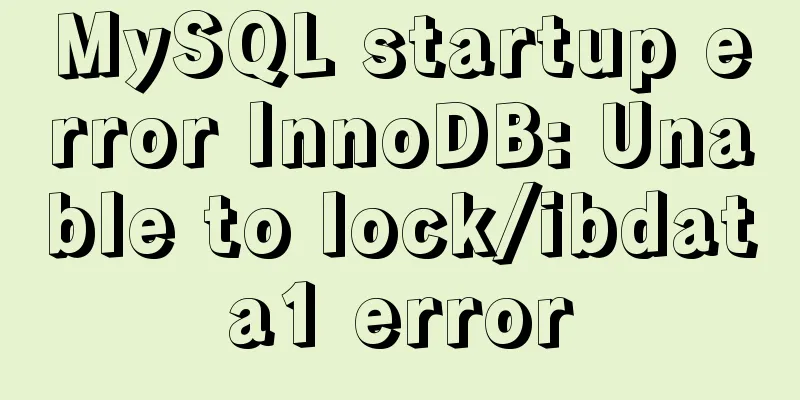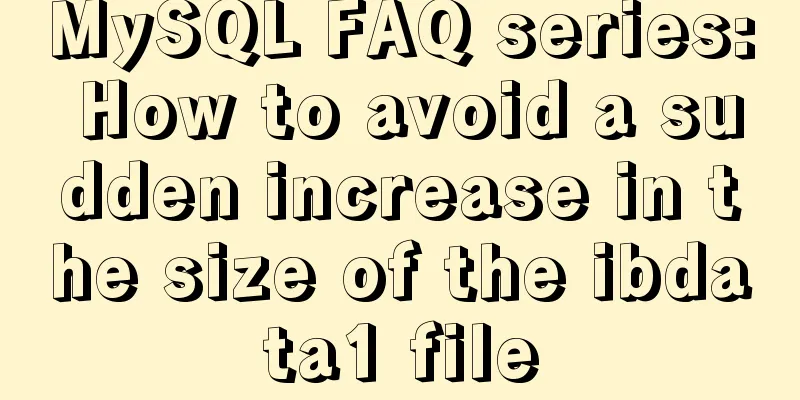MySQL startup error InnoDB: Unable to lock/ibdata1 error

|
An error message appears when MySQL is started in OS X environment: 016-03-03T00:02:30.483037Z 0 [ERROR] InnoDB: Unable to lock ./ibdata1 error: 35 2016-03-03T00:02:30.483100Z 0 [Note] InnoDB: Check that you do not already have another mysqld process using the same InnoDB data or log files. The terminal keeps printing the above error log repeatedly. From the error log, it seems that another mysqld process has occupied the ./ibdata1 file. So use the ps command to check whether there is a mysqld process running: ps -ef |grep mysqld 74 7711 1 0 8:04AM?? 0:00.34 /usr/local/mysql/bin/mysqld --user=_mysql --basedir=/usr/local/mysql --datadir=/usr/local/mysql/data --plugin-dir=/usr/local/mysql/lib/plugin --log-error=/usr/local/mysql/data/mysqld.local.err --pid-file=/usr/local/mysql/data/mysqld.local.pid It was found that there was a 7711 process running, so it was killed forcefully: sudo kill -9 7711 Query again with ps: ps -ef |grep mysqld 74 7759 1 0 8:10AM?? 0:00.29 /usr/local/mysql/bin/mysqld --user=_mysql --basedir=/usr/local/mysql --datadir=/usr/local/mysql/data --plugin-dir=/usr/local/mysql/lib/plugin --log-error=/usr/local/mysql/data/mysqld.local.err --pid-file=/usr/local/mysql/data/mysqld.local.pid It is still there, but the pid has changed from the original 7711 to the current 7759. Then see which files the mysqld process has opened: lsof -c mysqld The process doesn't have any files open, that's the problem.
So run again: sudo lsof -c mysqld COMMAND PID USER FD TYPE DEVICE SIZE/OFF NODE NAME mysqld 8655 _mysql cwd DIR 1,4 544 3090250 /usr/local/mysql/data mysqld 8655 _mysql.txt REG 1,4 31130736 3089789 /usr/local/mysql/bin/mysqld Indeed, I found that there is a real mysqld process running, which also occupies these mysql files. After some Google, I found that the way to start MySQL in OS X is completely different from that in Linux. The correct way to start/restart MySQL in OS X is: sudo launchctl unload -w /Library/LaunchDaemons/com.oracle.oss.mysql.mysqld.plist Now let's see if there is still a mysqld process: ps -ef |grep mysqld Well, I found that it is indeed gone, so I started MySQL again: sudo launchctl load -w /Library/LaunchDaemons/com.oracle.oss.mysql.mysqld.plist The problem is finally solved, but it’s not over yet. We have to figure out the principle. What is LAUNCHD? Launchd is a key process introduced in Mac OS X since 10.4. It is used to initialize the system environment. It is the first process started in the OS environment after the kernel is loaded successfully. Traditional Linux uses /etc/rc.* or /etc/init to manage services to be started at boot, while OS X uses launchd to manage them. It is very simple to configure startup items in this way, and only one plist file is needed. The plist files in the /Library/LaunchDaemons directory are all processes that are started immediately after the system starts. Use the launchctl command to load/unload the plist file. After loading the configuration file, the program starts, and after unloading the configuration file, the program closes. After uninstalling the configuration file, try to start the mysql process directly using the mysqld command: /usr/local/mysql/bin/mysqld 2016-03-03T01:35:50.359258Z 0 [ERROR] InnoDB: ./ib_logfile0 can't be opened in read-write mode. 2016-03-03T01:35:50.359283Z 0 [ERROR] InnoDB: Plugin initialization aborted with error Generic error 2016-03-03T01:35:50.670517Z 0 [ERROR] Plugin 'InnoDB' init function returned error. 2016-03-03T01:35:50.670555Z 0 [ERROR] Plugin 'InnoDB' registration as a STORAGE ENGINE failed. 2016-03-03T01:35:50.670568Z 0 [ERROR] Failed to initialize plugins. 2016-03-03T01:35:50.670574Z 0 [ERROR] Aborting ib_logfile0 cannot be opened. It is probably a user permission file. MySQL cannot be started with the current system user. Then add sudo and start it as root: 2016-03-03T01:38:10.977313Z 0 [ERROR] Fatal error: Please read the "Security" section of the manual to find out how to run mysqld as root! 2016-03-03T01:38:10.977339Z 0 [ERROR] Aborting 2016-03-03T01:38:10.977350Z 0 [Note] Binlog end 2016-03-03T01:38:10.977410Z 0 [Note] /usr/local/mysql/bin/mysqld: Shutdown complete Tell me to read the MySQL security manual and start it with launchd. The above is the full content of this article. I hope it will be helpful for everyone’s study. I also hope that everyone will support 123WORDPRESS.COM. You may also be interested in:
|
<<: Vue two same-level components to achieve value transfer
>>: How to use port 80 in Tomcat under Linux system
Recommend
Vue implements the full selection function
This article example shares the specific code of ...
Detailed tutorial on how to install mysql8.0 using Linux yum command
1. Do a good job of cleaning before installation ...
How to make a website look taller and more designed
“How to make a website look high-end? Or more des...
CSS code to achieve 10 modern layouts
Preface I watched web.dev's 2020 three-day li...
How to use dl(dt,dd), ul(li), ol(li) in HTML
HTML <dl> Tag #Definition and Usage The <...
About MYSQL, you need to know the data types and operation tables
Data Types and Operations Data Table 1.1 MySQL ty...
CSS3 uses transform to create a moving 2D clock
Now that we have finished the transform course, l...
Will CSS3 really replace SCSS?
When it comes to styling our web pages, we have t...
11 Linux KDE applications you didn't know about
KDE Abbreviation for Kool Desktop Environment. A ...
How to determine if the Linux system is installed on VMware
How to determine whether the current Linux system...
VMware Workstation 12 Pro Linux installation tutorial
This article records the VMware Workstation 12 Pr...
Detailed explanation of MySQL's Seconds_Behind_Master
Table of contents Seconds_Behind_Master Original ...
A brief explanation of the reasonable application of table and div in page design
At the beginning of this article, I would like to ...
Tutorial diagram of installing TomCat in Windows 10
Install TomCat on Windows This article will intro...
In-depth explanation of the failure of writing SQL containing English single quotation marks "''"
I have encountered a problem. When testing the ed...









